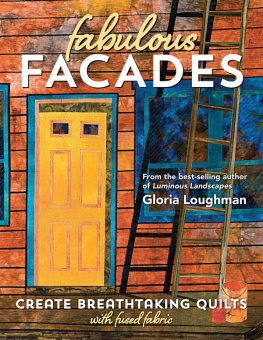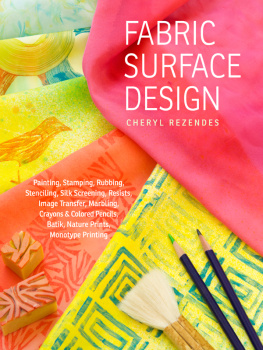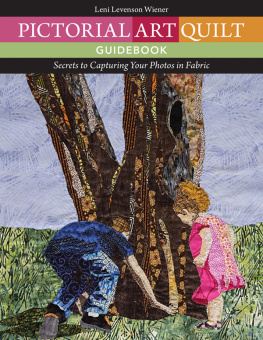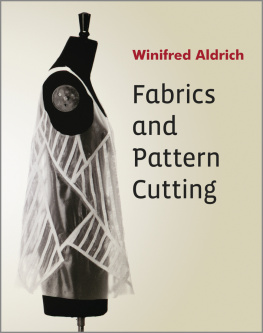
DEDICATION
I would like to dedicate this book to our much-loved grandchildren: Charlotte, Declan, Malachi, Lucy, Benjamin, Artemis, and Evie. The joy and richness you have brought to our lives have certainly been something very special.
I would also like to dedicate this book to the farming communities of Kerang, Murrabit, and Benjeroop, which were inundated with floodwater in early 2011 and are still on the long road back to recovery. Your strong spirit and determination, your endeavors to look after your neighbors, and your physical efforts have been inspirational.
ACKNOWLEDGMENTS
Thank you to C&T Publishing, yet again, for undertaking the publication of this book. To my friend and editor, Lynn Koolish, goes a special thank-you. Signing on for a third time takes amazing fortitude, and I really appreciate your expertise and patience.
Thank you to my parents, Florence and Jack, for your love and positive encouragement.
Thank you also to our daughters, Amanda, Sarah, and Rebecca, who are always ready to be a sounding board and are very willing to give practical help and advice. I treasure the close relationship we share as a family.
And to my husband, Tony, what can I say? As photographer extraordinaire, you have made an outstanding contribution to this book. Your knowledge, expertise, and patience when photographing samples have been invaluable. Your folio of photos of our travels is exceptional, and I am very proud to include many of these photos as inspiration. I really value the time we have spent working together on this book and your infinite support for my endeavors.

L OOKING AT LIGHT
I have always been drawn to the paintings of the impressionists. From Monet and Renoir to Cezanne and Van Gogh, their work has always held a fascination for me. I view their paintings as a visual feast through their efforts to capture light.
A visit to the Van Gogh museum in the Netherlands instilled in me a longing to create with color. Van Gogh painted with passion, concentrating on painting the light. He liked to paint directly from nature, not caring whether his colors were true to nature, as long as the result looked beautiful on his canvas.
Light catches the eye. It pulls the viewer into a picture as it reveals the colors and shapes of the elements. When the light is just right, commonplace subjects are transformed and become noticed.
The sun and the moon are sources of natural light. The kind of light they produce varies from bright sunlight directly overhead on a clear day to just the barest hint of light coming from a sliver of the crescent of a new moon.
Light sets the mood. When the light is bright and overhead and the colors are strong and saturated, there is a feeling of warmth and energy. When the dominant color of the landscape is gray and the mist hovers in the trees, the mood is more mystical and mysterious.
Using light as a focus will make your work special. Light is a very important element, and it is crucial that you learn how to capture light in your work.
Showcase the light in your paintings by placing the greatest contrast between light and dark at the focal point. Limiting the amount of light and then focusing it on the important elements creates drama and impact.
The use of mosaic tiles echoes some of the work of the impressionists and the pointillists. Using brushstrokes or tiny dots of color, those artists were able to create a beautiful harmonious effect of gradual changes of color and value. Apparently, optical mixing occurs when the colors are not physically combined but are juxtaposed so that the eye is unable to differentiate individual colors from a distance. They are perceived as a rich mixture, having the average brightness of the component colors. They certainly have a special beauty and luminosity.
Tiling large areas of your quilts allows you, in some ways, to follow in these master painters footsteps. By creating the tiles from a rich palette of colors and textures, you can gradually make changes in color and value, creating movement and interest. You can make the light flow around your design, weaving its magic.

Light just catches side of white lions face.

Backlighting of setting sun in the White Desert of Egypt
HOW TO USE THIS BOOK
Where do new ideas come from? Often events or images trigger a response, and our reaction is either to disregard this trigger or to embrace it, run with it, experiment with it, dream of it. This was my reaction to a small sample I made when writing Quilted Symphony. It was a small sample made with rectangles, placed at an angle over a dark background. Then the thought came: This could make a great sky! So the new journey began.
Using small tiles, rather than larger pieces of fabric, gives me the flexibility of incorporating many colors, values, and textures in one small area. I have been endeavoring for a long time to add the dimension of radiant light to my work. This is one way to make it possible.
Take the Journey
After you read the sections on design and color, reassess your fabric stash, searching out suitable fabrics. Perhaps you will be tempted to paint some fabric for yourself or to try dyeing. I can assure you that the mess and your efforts will be rewarded tenfold.
The section on design will help you create your own pattern, but if you want to try the techniques without making your own design, there are four projects included at the end of the book.
Once you have the pattern drawn out and have selected the fabrics, the chapters on construction will lead you through the process of tiling and building up the background. You might try tiling a sky, mountains, or a body of water. Indeed, you could tile the whole landscape for a beautiful effect.
The background segments are quilted as they are applied. So for this technique, the final step is to add foreground elements or surface decoration such as trees, figures, buildings, or any other image you would like to include.
There are many ways to finish the edges of a quilt. A faced edge has a contemporary feel to it, but some designs need more definition. A number of strategies, including a very narrow border, are presented.
I have really enjoyed using the tiling process in my own work. I am still thrilled and excited by the effects I can achieve with mosaic tiles. I hope you enjoy using these techniques and find that you can create your own stunning landscapes, full of radiant light.
DESIGNING YOUR QUILT

Diamond tiles in sky create tranquility.
Lakeside by Gloria Loughman, 22 15 (56cm 38cm)
The first step in designing your quilt is to search for a place or scene that captures your attention. Some scenes actually jolt you into action. They reach out to you and almost demand to be featured.
I have found that many quilt artists seem almost supersensitive to their surroundingsthey are always on the hunt for a subject to be explored, an idea to be tossed around, a scene to be interpreted. It is quite addictive and exhilarating to be always on the lookout for your next potential subject.
Next page
















